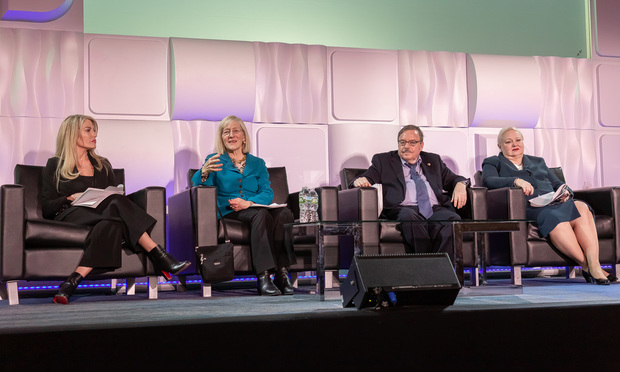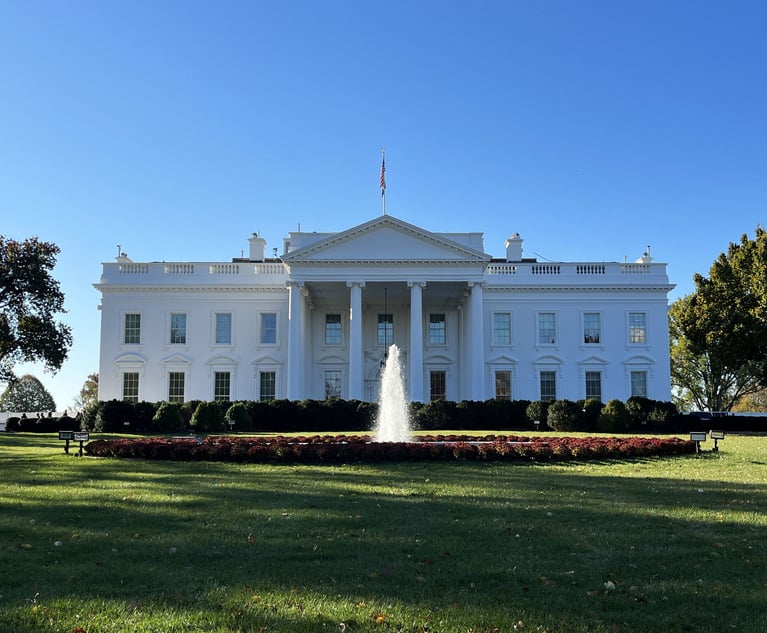When E-discovery Became a Thing: Judges Reflect Court's ESI Evolution
There was a time when Andrew J. Peck, retired U.S. magistrate judge from the SDNY and now senior counsel at DLA Piper in NY, didn't realize e-discovery was going to become a big deal.
January 31, 2019 at 10:37 AM
5 minute read
The original version of this story was published on Legal Tech News
 Magistrate Judge Kimberly C. Priest Johnson of the U.S. District Court for the Eastern District of Texas (from left), Magistrate Judge Elizabeth D. Laporte of the U.S. District Court for the Northern District of California, retired Magistrate Judge Andrew J. Peck and DLA Piper senior counsel, Chief Judge Joy Conti of the U.S. District Court for the Western District of Pennsylvania. (Photo: Carmen Natale/ALM)
Magistrate Judge Kimberly C. Priest Johnson of the U.S. District Court for the Eastern District of Texas (from left), Magistrate Judge Elizabeth D. Laporte of the U.S. District Court for the Northern District of California, retired Magistrate Judge Andrew J. Peck and DLA Piper senior counsel, Chief Judge Joy Conti of the U.S. District Court for the Western District of Pennsylvania. (Photo: Carmen Natale/ALM)
The second day of Legalweek 2019 closed out with a panel of current and retired federal judges discussing everything from the first time they became acquainted with e-discovery to what amendments to the 2015 Federal Rules of Civil Procedure are working.
Panelists included Andrew J. Peck, retired U.S. magistrate judge, who is currently senior counsel at DLA Piper; Chief Judge Joy Conti of the U.S. District Court for the Western District of Pennsylvania; Magistrate Judge Elizabeth Laporte of the Northern District of California; and Magistrate Judge Kimberly Priest Johnson of the Eastern District of Texas.
Here are the highlights from the talk:
When E-discovery Took Center Stage
The judges on the panel weren't always e-discovery experts. In fact, some can recall a time when they thought e-discovery wouldn't be as big a deal as it is today.
For Peck, that time was shortly after the 2006 discovery amendments to the FRCP, which discussed electronically stored information.
“I think the first tipping point was the 2006 rules amendments,” he said, noting that after he talked about the rules at a conference, some took him for an e-discovery expert. But Peck didn't think e-discovery would be a topic he would be talking about for long.
“I thought, 'OK, we are going to have all these nice new rules and therefore give everyone a year to figure it out, then I'll have to go find something else to talk about because everyone will have figured it out.' Obviously, we're still talking about.”
For Laporte, e-discovery came to light after a 2006 case she managed regarding alleged patent infringement of source code. “I had to write this length opinion dealing with serious sanctions that went through all the many thing that went completely wrong … the word ESI was only mentioned one.”
She continued, “Then to my surprise a few weeks later, someone calls me up and says, 'You are just this expert on e-discovery, would you headline our conference.' … and I said, 'What are you talking about?' I didn't realize this would come a buzzword, if not a field.”
Things Change, Stay the Same
While e-discovery processes have become better known over the past decade, there is still the persistent problem of attorneys and judges not understanding new sources of ESI.
“In 2005 and even after the 2006 rule change, lawyers were still coming into the court—those of a certain age—and pointing to their grey hair and bald head and saying, 'I'm sorry judge I still don't understand how to deal with emails and ESI,'” Peck recalled.
Now, “I think we are seeing with text messages and some other forms of non-email communication” the same problem, he added. “ But we all as lawyers and judges need to learn how to deal with the newer forms of technology, just as we had to learn back in 2005 and 2006 how to deal with email.”
But adapting to new data sources may be easier now than it was over a decade ago. Judge Conti noted that “the big difference today than before is judges are more attune to” new technology and ESI. “Perhaps not every judge, but we have had a lot of judicial education over this.”
Still, she noted that it is still difficult for all legal professionals to keep up with the evolution of technology. “It's incredible, the pace of change is so fast in this field it makes it interesting, but it's also very difficult for the partners to keep up, let alone the judges.”
The Amendments That Work
Peck and Johnson agreed that changes to FRCP rule 26 instilling proportionality in discovery request has, for the most part, caught on in the legal industry. “No one ever talked about [proportionality] when I was a lawyer; I never thought to make a proportionality argument,” Johnson said.
“But I would say a positive thing … is that I don't see boilerplate objections anymore. I think parties realize, if we are going to make these objections [judges] want specifics, how much is this going to cost what is the burden.”
Johnson also praised the changes to rule 16 that mandate a meet-and-confer conference, which she believes helped decrease the amount of discovery disputes in her court. “I believe in large part it's because of the specific requirements in conference.”
This content has been archived. It is available through our partners, LexisNexis® and Bloomberg Law.
To view this content, please continue to their sites.
Not a Lexis Subscriber?
Subscribe Now
Not a Bloomberg Law Subscriber?
Subscribe Now
NOT FOR REPRINT
© 2025 ALM Global, LLC, All Rights Reserved. Request academic re-use from www.copyright.com. All other uses, submit a request to [email protected]. For more information visit Asset & Logo Licensing.
You Might Like
View All

Legal Speak's 'Sidebar with Saul' Part IV: Deliberations Begin in First Trump Criminal Trial
1 minute read
'What Are We Fixing?': ABA Rejects Proposal to Make Law School Admissions Tests Optional
7 minute read
First Department Announces Some In-Person Arguments to Resume
Trending Stories
- 1How ‘Bilateral Tapping’ Can Help with Stress and Anxiety
- 2How Law Firms Can Make Business Services a Performance Champion
- 3'Digital Mindset': Hogan Lovells' New Global Managing Partner for Digitalization
- 4Silk Road Founder Ross Ulbricht Has New York Sentence Pardoned by Trump
- 5Settlement Allows Spouses of U.S. Citizens to Reopen Removal Proceedings
Who Got The Work
J. Brugh Lower of Gibbons has entered an appearance for industrial equipment supplier Devco Corporation in a pending trademark infringement lawsuit. The suit, accusing the defendant of selling knock-off Graco products, was filed Dec. 18 in New Jersey District Court by Rivkin Radler on behalf of Graco Inc. and Graco Minnesota. The case, assigned to U.S. District Judge Zahid N. Quraishi, is 3:24-cv-11294, Graco Inc. et al v. Devco Corporation.
Who Got The Work
Rebecca Maller-Stein and Kent A. Yalowitz of Arnold & Porter Kaye Scholer have entered their appearances for Hanaco Venture Capital and its executives, Lior Prosor and David Frankel, in a pending securities lawsuit. The action, filed on Dec. 24 in New York Southern District Court by Zell, Aron & Co. on behalf of Goldeneye Advisors, accuses the defendants of negligently and fraudulently managing the plaintiff's $1 million investment. The case, assigned to U.S. District Judge Vernon S. Broderick, is 1:24-cv-09918, Goldeneye Advisors, LLC v. Hanaco Venture Capital, Ltd. et al.
Who Got The Work
Attorneys from A&O Shearman has stepped in as defense counsel for Toronto-Dominion Bank and other defendants in a pending securities class action. The suit, filed Dec. 11 in New York Southern District Court by Bleichmar Fonti & Auld, accuses the defendants of concealing the bank's 'pervasive' deficiencies in regards to its compliance with the Bank Secrecy Act and the quality of its anti-money laundering controls. The case, assigned to U.S. District Judge Arun Subramanian, is 1:24-cv-09445, Gonzalez v. The Toronto-Dominion Bank et al.
Who Got The Work
Crown Castle International, a Pennsylvania company providing shared communications infrastructure, has turned to Luke D. Wolf of Gordon Rees Scully Mansukhani to fend off a pending breach-of-contract lawsuit. The court action, filed Nov. 25 in Michigan Eastern District Court by Hooper Hathaway PC on behalf of The Town Residences LLC, accuses Crown Castle of failing to transfer approximately $30,000 in utility payments from T-Mobile in breach of a roof-top lease and assignment agreement. The case, assigned to U.S. District Judge Susan K. Declercq, is 2:24-cv-13131, The Town Residences LLC v. T-Mobile US, Inc. et al.
Who Got The Work
Wilfred P. Coronato and Daniel M. Schwartz of McCarter & English have stepped in as defense counsel to Electrolux Home Products Inc. in a pending product liability lawsuit. The court action, filed Nov. 26 in New York Eastern District Court by Poulos Lopiccolo PC and Nagel Rice LLP on behalf of David Stern, alleges that the defendant's refrigerators’ drawers and shelving repeatedly break and fall apart within months after purchase. The case, assigned to U.S. District Judge Joan M. Azrack, is 2:24-cv-08204, Stern v. Electrolux Home Products, Inc.
Featured Firms
Law Offices of Gary Martin Hays & Associates, P.C.
(470) 294-1674
Law Offices of Mark E. Salomone
(857) 444-6468
Smith & Hassler
(713) 739-1250






